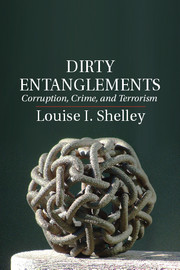Book contents
- Frontmatter
- Dedication
- Contents
- Figure, Maps, and Tables
- Acknowledgments
- Introduction
- Part I The Logic of Corruption, Crime, and Terrorism
- Part II The Diverse Businesses of Terrorism
- 5 The Business of Terrorism and Criminal Financing of Terrorism
- 6 The Drug Trade
- 7 The Less Policed Illicit Trade
- 8 Ultimate Fears
- Conclusion
- Index
- References
5 - The Business of Terrorism and Criminal Financing of Terrorism
Published online by Cambridge University Press: 05 August 2014
- Frontmatter
- Dedication
- Contents
- Figure, Maps, and Tables
- Acknowledgments
- Introduction
- Part I The Logic of Corruption, Crime, and Terrorism
- Part II The Diverse Businesses of Terrorism
- 5 The Business of Terrorism and Criminal Financing of Terrorism
- 6 The Drug Trade
- 7 The Less Policed Illicit Trade
- 8 Ultimate Fears
- Conclusion
- Index
- References
Summary
Osama bin Laden’s confiscated documents revealed that he was considering an increased use of kidnapping to generate money to fund his organization. With a decline in donor contributions amid efforts by Western powers to stop funds from ideological supporters reaching al-Qaeda, Bin Laden needed to generate more cash. As is increasingly common, he turned to traditional crime to fund terrorism – kidnapping. The reason that Osama favored this form of crime was not only its feasibility but its low risk and long-term use by terrorists as a funding source. Osama analyzed the success of al-Qaeda affiliates in North Africa (AQIM), Yemen (AQAP), and Iraq, who actively used kidnapping as a revenue generator. Some individual ransoms in North Africa have been as large as $2 million, and, since 2008, according to French experts, AQIM has gained $80 million through its kidnapping rackets. Government and multinational employees have sometimes been ransomed, but really significant profits were achieved by kidnapping individuals working for corporations, where the ransoms received were frequently greater. Kidnapping is now believed to be AQIM’s largest revenue source and enhances its ability to conduct operations.
It is hardly surprising that bin Laden reasoned like a businessman. His family owned one of the largest businesses of the Middle East. He grew up in a family of businesspeople, not a hereditary elite. His mother was the daughter of a Syrian trader.
- Type
- Chapter
- Information
- Dirty EntanglementsCorruption, Crime, and Terrorism, pp. 173 - 217Publisher: Cambridge University PressPrint publication year: 2014

